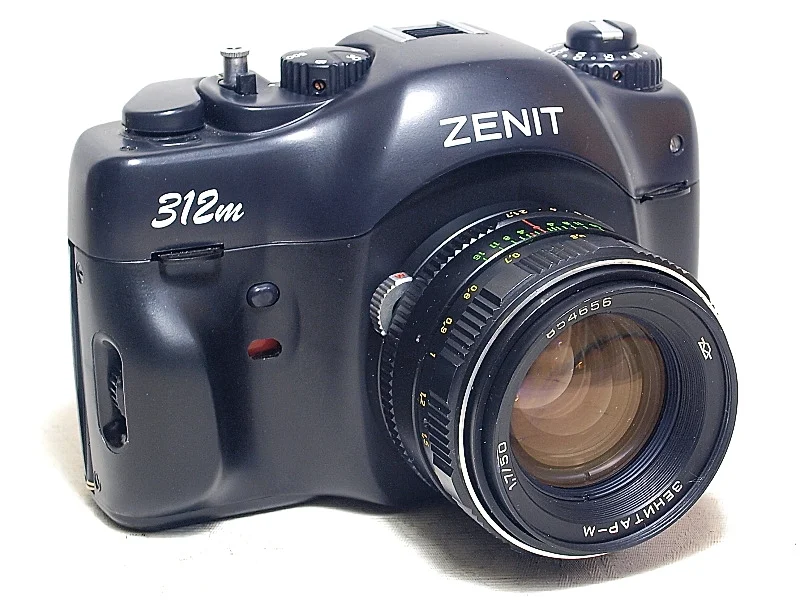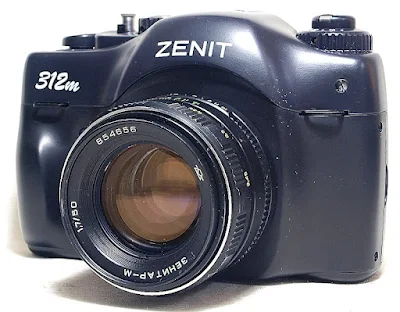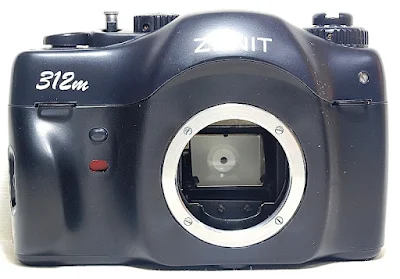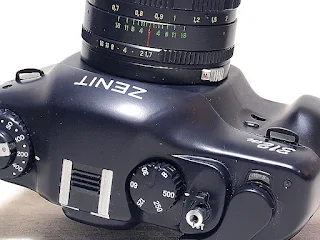The camera was part of a line of 35 mm SLR cameras that featured different lens mounts, designs, and body materials that were produced by KMZ.
The rounded and futuristic ABS plastic body of the Zenit 312m, and its predecessor, the K-mount 212m, was a break from previous Zenit models, which were normally characterized by bulky sizes and square features.
The Zenit 312m comes with a horizontal travel focal-plane shutter with a shutter speed selection of 1/30, 1/60, 1/250, and 1/500 seconds and B(ulb), accepts film with an ISO speed range from 12 to 800, and has a self-activated mechanical 6-10 second delay self-timer. Metering is open-aperture TTL (Through-the-Lens), activated by a half-press of the shutter button.
Correct exposure reading by way of either shutter-priority or aperture-priority shooting modes is indicated by a green diode on the lower right of the viewfinder screen. Under- and overexposed readings are indicated by a red diode. The camera is also fitted with a self-activated mechanical 6-10 second delay self-timer.
Zenit 312m
A brief guide to the Zenit 312M film camera
When compared to previous models of the series, the 212k and 312m iterations do come with a couple of advantages - a lighter body weight and better ergonomics.
Basic Camera Features
A simple front, with the lens mount extrusions slightly off-center to the right of the front plane, a stylish finger grip style self-timer fly-wheel dial cover on the left edge of the front plane, with a small red/green self-timer window, and the self-timer activation button above it.
On the left end of the top plane is the film rewind crank integrated with the film back pull-up latch lock, and turn to select the film ASA speed dial. On top of the pentaprism hump is the hot shoe, and to the right of the hump is the shutter speed selector dial, the shutter release, film rewind release buttons, the film forward crank, and the film counter window.
The film back is a simple and plain affair with a nice sculptured hinged film back with a film indicator window, the viewfinder eyepiece at the back of the pentaprism hump, with the battery chamber on the left next to it.
On the bottom plane, just the tripod socket.
The film box is the normally seen film load system as employed by most 35mm SLR film camera manufacturers of the era, with the film canister chamber, shutter window, film sprocket gear, and the multi-slot film pickup spool laid from left to right.
Film Loading and Rewinding
To load film into the camera, open the film back, drop the film canister into the chamber (located on the left of the film box), pull the film tab across over the shutter window area, and insert the film end into a slot on the multislot take-up spool.
Ensure that the film is firmly aligned (with no slack) across the film box, close the film back, crank the film forward, and do the 2-blank shot sequence to bring the unexposed part of the film to Frame 1. Set the film ASA speed dial to the film roll you are using, and you're ready to roll.
To rewind the film at the end of the film roll, first, press the film rewind release button located at the front of the shutter release button until it clicks into place, next, flip out the film rewind crank lever and crank it in the clockwise direction until the film is fully wound back into the film canister.
Viewfinder Readout
The viewfinder of the Zenit 312m is a triple wedge viewfinder screen with ground glass, microprism, and horizontal split rangefinder rings, with illuminated diode displays on the right frame of the screen.
Correct exposure reading by way of either shutter-priority or aperture-priority shooting modes is indicated by a green diode in the middle of the right frame of the viewfinder screen. Under- and overexposed readings are indicated by a red diode on the lower and upper parts of the right frame.
Image Capture
Being a fully manual camera, image capture on the Zenit 312m is a straightforward two-handed process of setting the lens aperture opening and shutter speed combination to a Green diode display on the viewfinder screen, and you are ready to release the shutter.
- If you are using the shutter-priority approach, first set the shutter-speed selector to the speed you want to capture the image with, next frame and focus the image, and adjust the lens aperture opening to the correct meter reading before releasing the shutter.
- For aperture-priority image capture, do the opposite. First, set the lens aperture opening to the opening you want to capture the image with. Next, frame and focus the image, and adjust the shutter speed to the correct meter reading, again, before releasing the shutter.
Using the Self-Timer
The self-timer on the Zenit 312m is a self-activated system with a slightly different twist to its execution than what you will find on other 35mm SLR film camera makes and models.
To execute it properly, first, crank the film forward; next, press the shutter release button halfway down and give it a twist to the right to lock it in place. Next, turn the flywheel dial, on the side of the finger grip bump on the front of the camera, up for a couple of pushes to turn the self-timer color from red to green.
Press the self-timer button to execute the self-timing sequence.
Time Exposure
The best option for timed exposures, or extended exposure low-light shots, is to set the camera on a stand or tripod, or on a firm surface with the shutter release activated via a lockable shutter release cable. This will help reduce or eliminate the chances of contact vibration or physical movement during the period when the camera should be absolutely still.
Battery and Camera Body Weight
The Zenit 312m requires a pair of LR44 or SR44 button cells to operate the metering system and shutter speed control. The camera is still fully functional, albeit without the exposure metering function when the batteries are dead or depleted.
The camera's body weight is 540 grams without batteries.
In Use
The Zenit 312m, though solidly built, may not feel as firm in your hands as you would expect it to be, is still an interesting camera to start a conversation with, or to learn basic photography skills. If you are already an advanced enthusiast, the '312m' is a model you can use to sharpen your fully manual image captures.
The compact, lightweight body of the Zenit 312m is handy and convenient to lug around, and it will not burden you with a lot of excessive weight. The camera is easy enough for a beginner to use and is comfortable with, while having the added advantage of access to a wide and varied range of M42 mount lenses that are easily available on the market.





















No comments:
Post a Comment